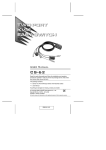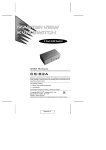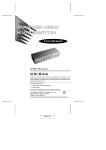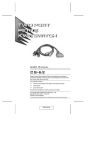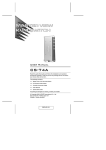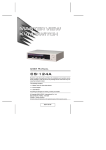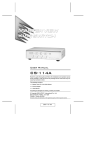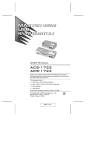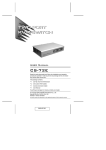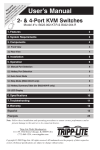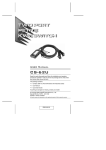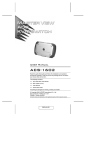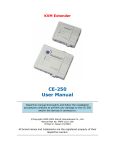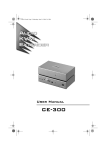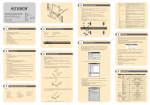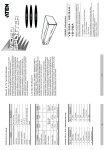Download Manual - EPA Systemy
Transcript
User Manual CS-64A Read this guide thoroughly and follow the installation and operation procedures carefully in order to prevent any damage to the unit and/or any devices that connect to it. This package contains: M 1 CS-64A Four Port Petite KVM Switch with Attached Cables M 1 User Manual M 1 Quick Start Guide If anything is damaged or missing, contact your dealer. © Copyright 2003 ATEN® International Co., Ltd. Manual Part No. PAPE - 1235-1AT Printed in Taiwan 08/2003 All brand names and trademarks are the registered property of their respective owners. 2003-08-26 Note: This equipment has been tested and found to comply with the limits for a Class B digital device, pursuant to Part 15 of the FCC Rules. These limits are designed to provide reasonable protection against harmful interference in a residential installation. This equipment generates, uses and can radiate radio frequency energy, and if not installed and used in accordance with the instruction manual, may cause interference to radio communications. However, there is no guarantee that interference will not occur in a particular installation. If this equipment does cause harmful interference to radio or television reception, which can be determined by turning the equipment off and on, the user is encouraged to try to correct the interference by one or more of the following measures: M Reorient or relocate the receiving antenna; M Increase the separation between the equipment and receiver; M Connect the equipment into an outlet on a circuit different from that which the receiver is connected; M Consult the dealer or an experienced radio/television technician for help. 2003-08-26 Overview The CS-64A Petite KVM Switch is a control unit that allows access to four computers from a single console (keyboard, monitor, and mouse). Before the development of the CS-64A, the only way to control multiple computer configurations from a single console was through a complex and costly network system. Now, with a CS-64A Petite KVM Switch installation, you can easily access four computers in a cost effective manner. The CS-64A improves on previous models with a 50% smaller footprint and attached custom KVM cables. The result is a neat and tidy workspace and trouble-free installation. Recognizing the increased importance of sound, the CS-64A is speaker enabled. You can listen to the audio output of all the computers (one at a time) on a single set of speakers. Setup is fast and easy; plugging cables into their appropriate ports is all that is entailed. Simple Hotkey combinations control which computer has the KVM focus. There is no software to configure, no installation routines, and no incompatibility problems. Since the CS-64A intercepts keyboard input directly, it works on any hardware platform and with all operating systems. There is no better way to save time and money than with a CS-64A installation. By allowing a single console to manage all of the computers, the CS-64A eliminates the expense of purchasing a separate keyboard, monitor, and mouse for each. Additionally, it saves the extra space they would take up, and eliminates the inconvenience and wasted effort involved in constantly having to move from one computer to the other. -1- 2003-08-26 Features M One console controls four computers M Compact design features four attached 4-in-1 KVM (keyboard, video, mouse, and speaker) cables M Speaker enabled M Easy to install - no software required - connecting cables to the computers is all it takes M Easy to operate - computer selection via Hotkeys - Auto Scan function to monitor computer operation M Hot pluggable - add or remove computers for maintenance without powering down the switch M LED display for easy status monitoring M Keyboard and mouse emulation for error free computer booting M Supports Microsoft IntelliMouse and the scrolling wheel on most mice M Caps Lock, Num Lock, and Scroll Lock states are saved and restored when switching M Superior video quality - up to 2048 x 1536; DDC2B M Compatible with all operating platforms M Non-powered -2- 2003-08-26 Hardware Requirements Console M A VGA, SVGA, or Multisync monitor capable of the highest resolution that you will be using on any computer in the installation. M A PS/2 Style Mouse. M A PS/2 Keyboard. Computers The following equipment must be installed on each computer that is to be connected to the system: M A VGA, SVGA or Multisync video card. M A 6-pin mini-DIN (PS/2 style) mouse port. M A 6-pin mini-DIN (PS/2 Style) keyboard port. Cables For optimum signal integrity and to simplify the layout, four high-quality 4-in-1 CS Custom KVM cables have been designed into the CS-64A. There is no need for a separate cable purchase. Note: The KVM cables have PS/2 style keyboard and mouse connectors. The CS-64A does not support AT keyboards or serial mice. -3- 2003-08-26 Front View 1 2 3 4 1. KVM Cables These 4-in-1 cables connect to the keyboard, video, mouse, and audio ports on the computers you are installing (see the Installation diagram on p. 6). 2. Port LEDs A LED lights to indicate its corresponding port is the one that has the KVM focus. Depending on the port’s status, the LED may flash according to a specific pattern (see the LED Display Table, p. 10, for details). 3. Speaker Jack The cable from your speakers (optional) plugs in here. 4. Console Ports Your keyboard, monitor, and mouse, plug in here (see the Installation diagram on p. 6). Each port is marked with an appropriate icon to indicate itself. -4- 2003-08-26 Installation 1. Before you begin, make sure that power to all the devices you will be connecting up have been turned off. You must unplug the power cords of any computers that have the Keyboard Power On function. Otherwise, the switch will receive power from the computer. 2. To prevent damage to your equipment, make sure that all devices you will be connecting up are properly grounded. Refer to the Installation diagram on the next page as you perform the following steps: 1. Plug your keyboard, monitor, mouse into the appropriate Console ports on the CS-64A. Each port is labeled with an appropriate icon to indicate itself. 2. (Optional) Plug your speakers into the CS-64A’s speaker jack. 3. Plug the attached KVM cables’ keyboard, monitor, mouse, and speaker connectors into their respective ports on the computers you are installing. After you have finished cabling up, turn on the power to the computers. Note: The CS-64A’s Power On default is to link to the first computer you turn on. -5- 2003-08-26 2 1 3 -6- 2003-08-26 Operation Accessing all of your computers from a single console could not be easier. The CS-64A uses Hotkey combinations to give the KVM focus to the computer of your choice. The CS-64A provides the following Hotkey features: M Selecting the Active Port M Auto Scan Mode M Skip Mode Invoking Hotkey Mode All Hotkey operations begin by invoking Hotkey Mode. Invoking Hotkey Mode takes three steps: 1. Press and hold down the Num Lock key 2. While [Num Lock] is down, press and release the asterisk key or the minus key 3. Release the Num Lock key: [Num Lock] + [*]; or: [Num Lock] + [-]; Note: The asterisk or minus key must be released within one half second, otherwise Hotkey invocation is canceled. When Hotkey Mode is active: M The keyboard Caps Lock and Scroll Lock LEDs flash in succession. They stop flashing and revert to normal status when you exit Hotkey Mode. M Ordinary keyboard and mouse functions are suspended only Hotkey compliant keystrokes and mouse clicks (described in the sections that follow), can be input. M Pressing [Esc] or [Spacebar] exits Hotkey Mode. -7- 2003-08-26 Selecting the Active Port Each CPU port is assigned a numeric Port ID (1 - 4). You can give the KVM focus directly to any computer on the installation with a Hotkey combination that specifies the ID of the port it is attached to. The steps involved are: 1. Invoke Hotkey Mode (see p. 7) 2. Press and release the appropriate Port ID number (1, 2, 3, or 4) After you press the number, the KVM focus switches to the designated computer and you automatically exit Hotkey Mode. Auto Scan Mode The CS-64A’s Auto Scan feature automatically cycles through the four ports at regular 5 second intervals. This allows you to monitor the computer activity without having to take the trouble of switching from port to port manually. To start Auto Scan Mode: 1. Invoke Hotkey Mode (see p. 7) 2. Press and release [A] Once scanning begins, it continues until you press [Esc] or [Spacebar] to exit Auto Scan Mode. The Port that is active at the time scanning stops remains active. Note: 1. Auto Scan only scans ports that are powered on. It passes over any powered off ports. 2. While Auto Scan Mode is in effect, ordinary keyboard and mouse functions are suspended. You must exit Auto Scan Mode by pressing [Esc] or [Spacebar] in order to regain normal control of their use. 3. Pressing [Esc] or [Spacebar] exits both Auto Scan Mode and Hotkey Mode. -8- 2003-08-26 Skip Mode This feature allows you to skip from the currently active Port to the Previous or Next one with a single keystroke. In contrast to Auto Scan Mode (which switches Ports at a fixed interval), you can dwell on a particular port for as long or as little as you like. To activate Skip Mode: 1. Invoke Hotkey Mode (see p. 7) 2. Press [ ← ] to skip from the current port to the port that comes before it (3 to 2; 2 to 1, etc.). 3. Press [ → ] to skip from the current port to the port that comes after it (1 to 2; 2 to 3; etc.). Note: 1. Skip Mode remains in effect until you exit it. You can use [ ← ] and [ → ] as often as you like. Ordinary keyboard and mouse functions are suspended - only [ ← ] and [ → ] can be input. You must exit Skip Mode in order to regain normal control of the console. 2. Pressing [Esc] or [Spacebar] exits both Skip Mode and Hotkey Mode. -9- 2003-08-26 Hotkey Summary Table Combination [Num Lock] + [*] or [Num Lock] + [-] Function [Port ID] Switches access to the computer that corresponds to that Port ID. [A] Invokes Auto Scan Mode [←] Switches access from the current port to the previous port. [→] Switches access from the current port to the next port. [Esc] or Exits Hotkey, Auto Scan, and Skip [Spacebar] Modes. LED Display Table Activity Indication Off Port is not selected. On (Steady) Port is connected to an active computer. Flashing (On and Off equal) Port is connected to an active computer and is being accessed in Auto Scan mode. - 10 - 2003-08-26 Specifications Function Specification Computer Connections 4 Port Selection Hot Keys LEDs Selected 4 Console Ports Keyboard 1 x 6 pin mini-DIN female (purple) Mouse 1 x 6 pin mini-DIN female (green) Video 1 x HDB-15 female (blue) Audio 1 x Earphone Jack (speaker) CPU Connectors Keyboard 4 x 6 pin mini-DIN male (purple) Mouse 4 x 6 pin mini-DIN male (green) Video 4 x HDB-15 male (blue) Audio 4 x Earphone plug (speaker) Scan Interval 5 Seconds Video Resolution 2048 x 1536; DDC2B Environment Operating Temperature: 0 - 50o C Storage Temperature: -20 - 60o C Humidity: 0 - 80% RH Noncondensing Housing Plastic Weight 0.9 kg Dimensions (L x W x H) 8.95 x 7.19 x 2.6 cm - 11 - 2003-08-26 Troubleshooting Symptom Keyboard Not Responding1 Pressing Hot Keys Gets No Response.2 Mouse Not Detected, or Does Not Respond Correctly.2 Possible Cause Action Loose cables. Check all keyboard cable connections to make sure they are completely seated in their sockets. Keyboard needs to be reset. Unplug the keyboard from the Console Keyboard Port, then plug it back in. Switch needs to be reset Turn off the computers. Unplug the KVM cables. Wait five seconds; then plug the cables back in and turn the computers on. Switch is in Auto Scan Mode. Press the [Spacebar] to exit Auto Scan Mode. Selected port Resend the Hotkey command connects to a selecting a port that has a powered On powered Off computer. computer attached. Hotkey sequence input incorrectly. Resend the Hotkey command - press and release each key in the sequence individually. Switch is in Auto Scan Mode. Press the [Spacebar] to exit Auto Scan Mode. Loose cables. Check all mouse cable connections to make sure they are completely seated in their sockets. Use of Mouse Port Adapters This unit is designed to only work with PS/2 mice and computers with PS/2 type mouse ports. Serial mouse ports with adapters cannot be used. Mouse needs to be reset. Unplug the mouse from the Console Mouse Port, then plug it back in. (Table continues on the next page.) - 12 - 2003-08-26 Symptom Mouse Not Detected, or Does Not Respond Correctly2 Video Problems Possible Cause Action Switch needs to be reset. Turn off the computers and unplug the KVM cables. Wait five seconds; then plug the cables back in and turn the computers on. Mouse set to Serial Mode. Some mice can be set to act as either a PS/2 or serial mouse. Make sure the mouse is set to PS/2 mode. Incorrect Mouse Driver. Check your Device Manager to be sure that the correct driver for your mouse (obtained from the manufacturer, or supplied by the operating system), has been installed. Resolution and/or Bandwidth set too high. Select a lower resolution and/or bandwidth. 1 The unit is designed to work with PS/2 keyboards. XT (84 key) and AT keyboards will not work. 2 Some Notebooks, notably the IBM Thinkpad and Toshiba Tecra, have trouble when their mouse and keyboard ports are used simultaneously. To avoid this, only connect the mouse port or the keyboard port. If you connect the mouse port, you will need to use the notebook’s keyboard when the notebook becomes the active computer. - 13 - 2003-08-26 Limited Warranty IN NO EVENT SHALL THE DIRECT VENDOR’S LIABILITY EXCEED THE PRICE PAID FOR THE PRODUCT FROM THE DIRECT, INDIRECT, SPECIAL, INCIDENTAL OR CONSEQUENTIAL DAMAGES RESULTING FROM THE USE OF THE PRODUCT, DISK OR ITS DOCUMENTATION. The direct vendor makes no warranty or representation, expressed, implied, or statutory with respect to the contents or use of this documentation, and specially disclaims its quality, performance, merchantability, or fitness for any particular purpose. The direct vendor also reserves the right to revise or update the device or documentation without obligation to notify any individual or entity of such revisions, or update. For further inquires please contact your direct vendor. - 14 - 2003-08-26
















